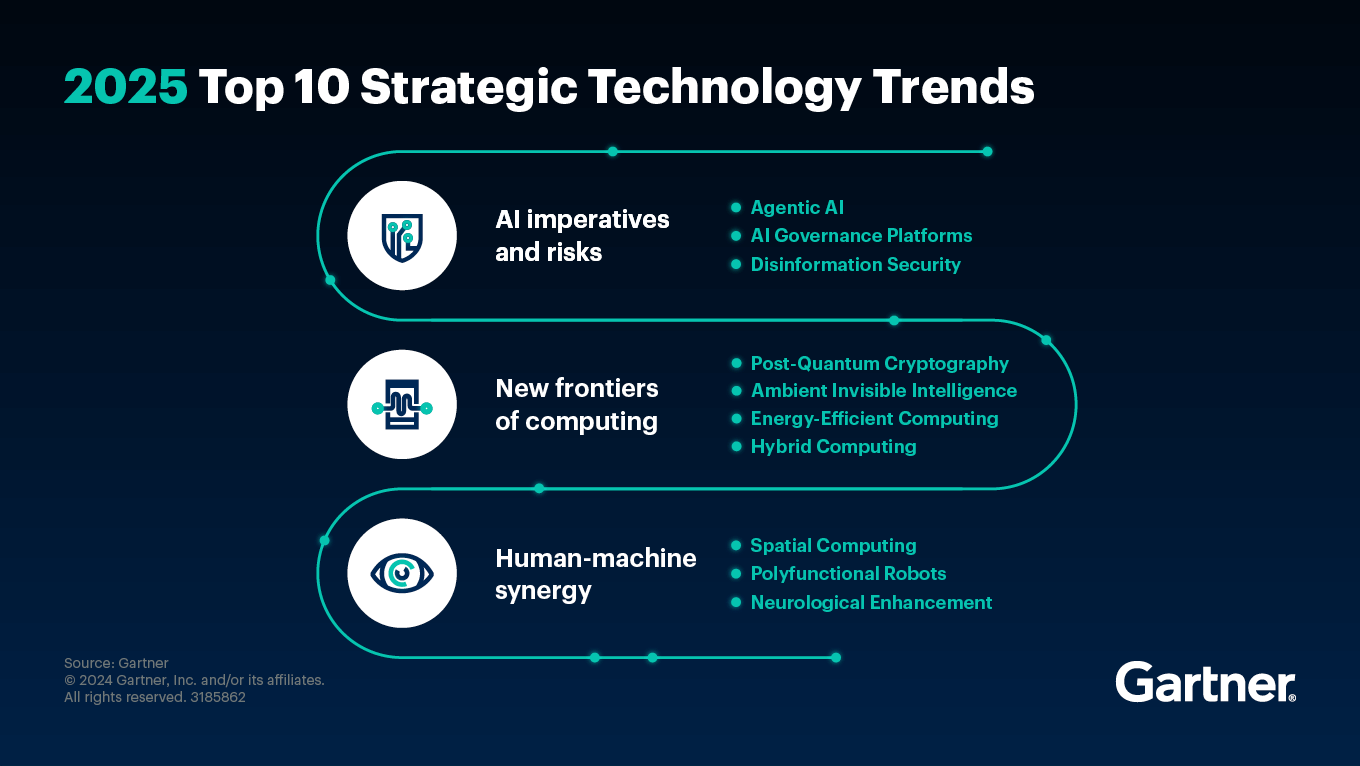By Gene Alvarez | October 21, 2024
Understanding and adopting emerging technologies are critical for CIOs and IT leaders to navigate the rapidly changing landscape of innovation. Gartner’s Top 10 Strategic Technology Trends for 2025 serve as a roadmap for addressing productivity, security, and innovation challenges while shaping the future through responsible technological advancements.
These trends are organized under three key themes: AI Imperatives and Risks, which explore the potential and challenges of artificial intelligence; New Frontiers of Computing, which redefine the role of computational systems; and Human-Machine Synergy, which highlights the convergence of physical and digital realities.
AI Imperatives and Risks
Artificial intelligence continues to transform industries, but its rapid advancement introduces significant responsibilities. Agentic AI, capable of autonomous decision-making, promises a virtual workforce to augment human productivity, but its implementation requires stringent safeguards to align outcomes with ethical standards. Meanwhile, AI Governance Platforms provide frameworks to manage legal, ethical, and operational challenges in AI systems, promoting transparency and accountability. However, the lack of uniform guidelines across industries complicates standardization efforts.
The emerging category of Disinformation Security targets growing threats to trust in digital environments. These technologies focus on mitigating fraud, strengthening identity validation, and protecting organizational reputations. To succeed, they must employ adaptive, multilayered systems capable of evolving alongside increasingly sophisticated threats.
New Frontiers of Computing
Innovations in computing are pushing organizations to rethink traditional architectures. Post-Quantum Cryptography (PQC) is emerging as a crucial safeguard against potential risks posed by quantum computing, offering robust data protection. However, integrating PQC into existing systems is complex and may require significant reengineering.
Another breakthrough is Ambient Invisible Intelligence, which embeds unobtrusive technologies into environments for intuitive interactions. This trend enhances efficiency through real-time tracking and sensing but raises privacy concerns, especially when users opt to disable tracking mechanisms.
Sustainability is also a major focus, with Energy-Efficient Computing prioritizing architectures, algorithms, and hardware designed to reduce energy consumption. While this approach addresses environmental and social pressures, transitioning to greener computing platforms is costly and technically demanding. Additionally, Hybrid Computing, which combines diverse computational resources, enables transformative AI capabilities and personalized applications. Despite its potential, hybrid computing’s complexity, high costs, and nascent status present significant barriers.
Human-Machine Synergy
The integration of physical and digital realities is reshaping user experiences. Spatial Computing, powered by augmented and virtual reality technologies, offers immersive experiences for industries like gaming, education, and e-commerce. However, challenges such as expensive hardware, complex interfaces, and data privacy concerns remain hurdles to widespread adoption.
Polyfunctional Robots, capable of multitasking and working seamlessly with humans, are redefining automation. Their adaptability supports scalability and cost efficiency, though the lack of industry standards complicates deployment.
Finally, Neurological Enhancement introduces technologies that interact with the brain to improve cognitive abilities, enhance safety, and enable personalized education. Despite its groundbreaking potential, the high costs, ethical dilemmas, and security risks associated with brain interfaces pose significant challenges.
Gartner’s strategic technology trends for 2025 highlight both immense opportunities and critical challenges in shaping the future of innovation. Organizations must navigate these technologies with foresight and responsibility, ensuring they contribute to sustainable and ethical progress.
Original Source: Gene Alvarez, Gartner Top 10 Strategic Technology Trends for 2025 (October 21, 2024).
Tel: +27 10 500 6867 / E: support@pro-space.co.za

